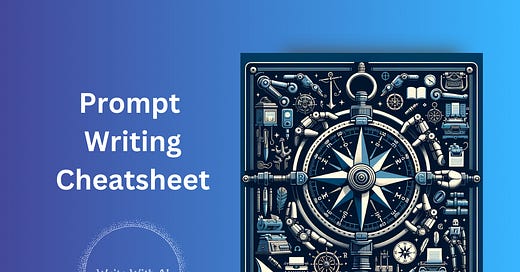Want to join The Creator Economy?
Hop aboard Ship 30 for 30 and start writing online!
If you have been thinking about writing online, or if you’ve been trying to write online by yourself and haven’t seen the results you’ve been hoping for, then let us help you. And as an added incentive to take ACTION, we are going to give you $100-off Ship 30 for 30.
BUT NOTE: This is a disappearing discount.
And 5 days from now (Sunday, May 5th) it will go away.
Click here to join Ship 30 for 30 and claim your $100-off discount.
We hope to see you on the other side.
Hey there, Digital Writers!
Great AI content starts with a great AI prompt.
Inputs determine outputs.
So, before I write a new prompt, I always start with the W.R.I.T.E.R.S Compass.
It’s a simple prompt template for guiding AI to create the content you want in less time.
Let’s dive in.
3 Mistakes Prompt Writers Make That Derail AI
Before we get to the framework, let me tell you about the 3 biggest mistakes I made when I was first getting started.
Mistake #1: Not giving clear instructions When I first started using AI, I didn't give it clear and detailed instructions. This led to the AI going off-topic. Now, I always include step-by-step instructions in my prompts to guide the AI in the right direction.
Mistake #2: Not providing examples I used to think that AI could understand what I wanted without any examples. But then I realized that AI learns better when it has examples to follow, just like humans do. Providing relevant examples helps the AI understand how to apply the instructions effectively.
Mistake #3: Not being specific about the target audience While it's obvious to target your audience, AI produces 10X better content when you give highly detailed information about your reader. Instead of just saying "I write for beginning writers," it's important to include specifics about their challenges, goals, concerns, and level of knowledge on the topic.
These mistakes are common—regardless of what you’re writing.
It took me a bit to see that writing prompts for AI is the same as any other kind of writing. The only difference is the fact that AI, not humans, will read it. Just like with any writing, you must give clear steps, useful examples, and think about what your reader (in this case, the AI) needs to get the best results.
The W.R.I.T.E.R.S Compass framework will help you sidestep these mistakes.
The W.R.I.T.E.R.S Compass
When you use this framework, you'll spend less time fiddling with prompts and more time polishing and publishing.
Let's take a look at the 7 key components of the framework:
Keep reading with a 7-day free trial
Subscribe to Write With AI to keep reading this post and get 7 days of free access to the full post archives.





